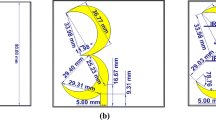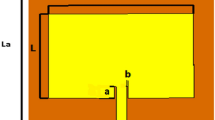Abstract
This paper presents a simple method for determining the dielectric constant of microwave PCB substrates. In the presented method, a bandpass microstrip filter designed on the PCB substrate with a user-predicted dielectric constant value is implemented for a given center frequency. The simulation results of the designed bandpass filter are obtained by the help of microwave design software; XFDTD®. Experimental results regarding the filter frequency characteristic are accomplished by means of a vector network analyzer. The simulation results of the designed filter are modified to overlap with the experimental ones by varying the dielectric constant value. When the simulation and experimental results are overlapped, the value of dielectric constant is accurately selected. In order to illustrate the validity of proposed method, the dielectric constant values of flame resistant-4 (FR4) substrates are acquired at IEEE 802.11b/g and IEEE 802.11a wireless local area network (WLAN) application frequencies. The results obtained by using the presented method agree with the previous studies in the literature.







Similar content being viewed by others
References
C. H. Riedell, M. B. Steer, M. R. Kay, J. S. Kasten, M. S. Basel, and R. Pomerleau, Dielectric characterization of printed circuit board substrates. IEEE Trans. Instrum. Meas. 39-2, 437–440 (1990).
B. Daigle, Printed circuit board material and design considerations for wireless applications. Proc. 46th Electron. Compon. Technol. Conf. 1, 354–357 (1996).
A. R. Djordjevi, R. M. Biljie, V. D. Likar-Smiljanic, and T. K. Sarkar, Wideband frequency-domain characterization of FR-4 and time-domain causality. IEEE Trans. Electromagn. Compat. 43, 662–667 (2001).
K. J. Bois, B. Kirk, M. Tsuk, and D. Quint, Simple and accurate determination of complex permittivity and skin effect of FR4 material in gigahertz regime. Proc. 53rd Electron. Compon. Technol. Conf. 1, 1277–1282 (2003).
M. D. Pozar, Microwave Engineering, (Wiley,New York, 2005).
L. S Napoli, and J. J. Huhges, A simple technique for the accurate determination of the microwave dielectric constant for microwave integrated circuits. IEEE Trans. Microwave Theor. Tech. MTT-19, 664–665 (1971).
S. H. Chang, H. Kuan, H. W. Wu, R. Y. Yang, and M. Weng, Determination of microwave dielectric constant by two microstrip line method combined with EM simulation. Microw. Opt. Technol. Lett. 48, 2199–2201 (2006).
A. Namba, O. Wada, Y. Toyota, Y. Fukumoto, Z. L. Wang, R. Koga, T. Miyashita, and A. Watanabe, A simple method for measuring the relative permittivity of printed circuit board materials. IEEE Trans. Electromagn. Compat. 43, 515–519 (2001).
J. Q. Howell, A quick accurate method to measure the dielectric constant of microwave integrated-circuit substrates. IEEE Trans. Microwave Theor. Tech. 21, 142–144 (1973).
Permittivity measurement of PC boards and substrate materials using HP4291A and HP16453A, Hewlett Packard Application Note, 1255-3.
J. G. Richings, An accurate experimental method for determining the important properties of microstrip transmission lines. Marconi Rev. 209–215 (1974).
J. M. Heinola, K. P. Latti, J. P. Strom, M. Kettunen, and P. Silventoinen, A stripline ring resonator method for determination of dielectric properties of printed circuit board material in function of frequency. Conference on Electrical Insulation and Dielectric Phenomena. 692–695 (2004).
K. Latti, J.-M. Heinola, M. Kettunen, J.-P. Strom, and P. Silventoinen, A review of microstrip t-resonator method in determination of dielectric properties of printed circuit board materials. Proc. IEEE Instrum. Meas. Technol. Conf. 1, 62–66 (2005).
A. H. Boughriet, C. Legrand, and A. Chapoton, Noniterative stable transmission/reflection method for low-loss material complex permittivity determination. IEEE Trans. Microwave Theor. Tech. 45, 52–57 (1997).
IEEE Standard for 802.11a, 1999.
IEEE Standard for 802.11b, 1999.
IEEE Standard for 802.11g, 2003.
XFDTD User’s Guide, Remcom Inc., 2007.
J. Branson, J. Naber, and G. Edelen, A simplistic printed circuit board fabrication process for course projects. IEEE Trans. Ed. 43, 257–261 (2000).
Acknowledgement
This work is supported by Mersin University - Scientific Research Projects with the grant number “BAP-FBE EEM (SY) 2006-4 YL”. The authors would also like to thank to Remcom Inc. for providing the electromagnetic software, XFDTD®.
Author information
Authors and Affiliations
Corresponding author
Rights and permissions
About this article
Cite this article
Yamacli, S., Ozdemir, C. & Akdagli, A. A Method for Determining the Dielectric Constant of Microwave PCB Substrates. Int J Infrared Milli Waves 29, 207–216 (2008). https://doi.org/10.1007/s10762-007-9317-6
Received:
Accepted:
Published:
Issue Date:
DOI: https://doi.org/10.1007/s10762-007-9317-6




